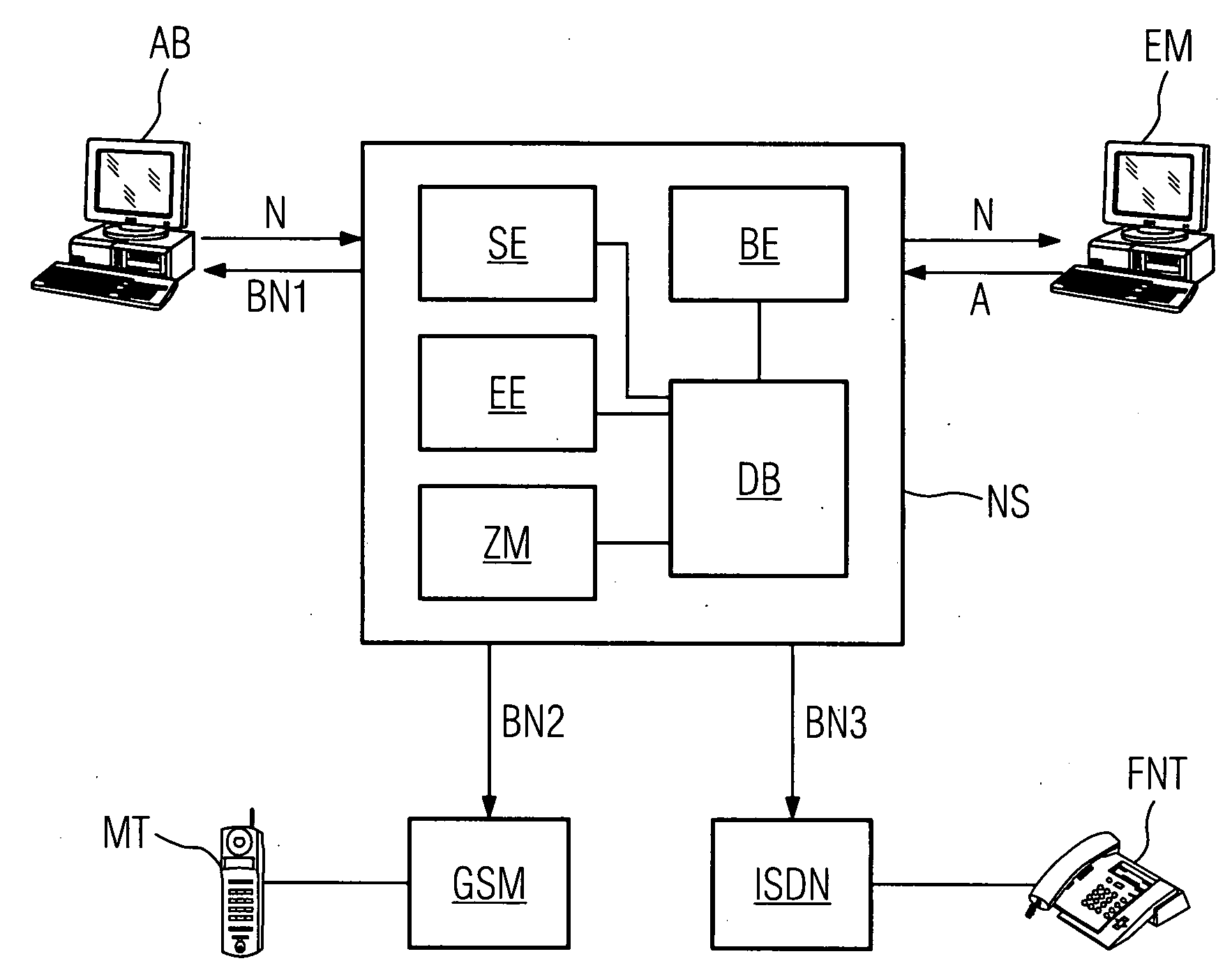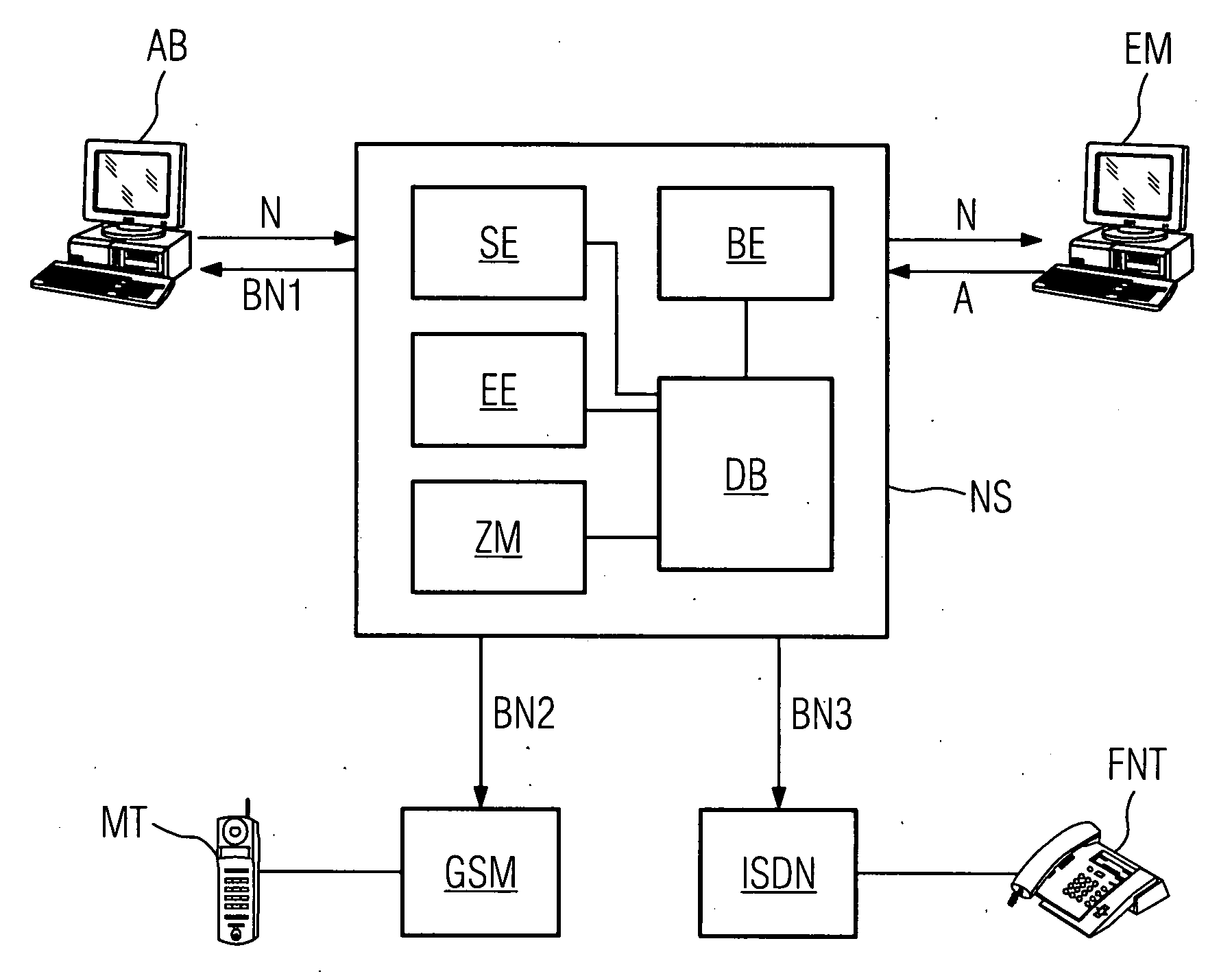[0008]It is therefore an object of the present invention to improve user convenience in the notification of incoming electronic messages.
[0010]The solution provides the use of a message server for
processing outgoing and incoming electronic messages, with a transmission facility for sending the electronic messages, with a
receiving facility for receiving the electronic messages, and with a notification facility for sending a notification message about the
receipt of the electronic messages. This message server has an allocation means for allocating a instruction to an electronic message which has been sent or is to be sent, this instruction enabling provision of the sending of the notification on the
receipt of an incoming reply message to this sent electronic message. The message server further includes a checking facility, which is set up to check the incoming electronic message, the check enabling it to be determined whether an incoming electronic message is a reply message to a previously sent electronic message equipped with a instruction. The message server is set up in such a way that, in the event of a positive result of the check, the notification message is sent. The use of such a message server allows the sending of a notification message to be restricted to those cases where the incoming message is a reply message to selected sent messages. Thus, for an electronic message which has been sent or is to be sent, it can be determined whether a notification message will be sent if a reply arrives to this—e.g. important—electronic message. With selective notification like this, it is possible to dispense with the requirement to be informed about every incoming electronic message, without missing an important reply message.
[0011]The object is further achieved with a method for notification of a user about the delivery of an electronic message, a notification message being sent to the user upon delivery of an electronic message. For this, in a first step an electronic message is created, in a second step the created electronic message is allocated a instruction for notification about a future incoming reply message, and in a third step the electronic message is sent. After this, in a fourth step a further electronic message is received, this received further electronic message being checked in a fifth step to establish whether this is a reply message to the message which was sent equipped with the instruction, and in a sixth step, if the result of the
check in the fifth step is positive, a notification corresponding to the instruction is sent. The third step can also occur before the second step, for example. By the use of this method, it is possible to specify for each sent electronic message whether a notification should follow for incoming reply messages to these electronic message which have been sent or are to be sent. The number of notification messages to be sent is thus reduced, without a reply message to a previously sent and correspondingly flagged (e.g. important) electronic message being missed.
[0018]It is advantageous if an electronic real-time message, for example a phone call or an SMS message, is used as the notification message. It is thereby ensured that the user is notified almost immediately.
[0019]The person to be notified is likely to be easily reached if the notification facility is set up to generate an automatic phone call to a user as a notification message. On the other hand, a notification is often found less annoying if the notification facility is set up to generate and send a text-based message as a notification message. This text-based message is an SMS message or an email message. In the case of the SMS message, the user can be reached immediately via his
mobile phone or another phone with an SMS facility, while if an email message is used, the notification can go to a further
email address of the user or of another user, without the complete delivered message having to be forwarded, as is the case with the known forwarding function of current email programs. It may be desirable for a user to not just be informed that a message has been delivered, but also to be sent further information about the reply message. For this, it is advantageous if the notification message includes at least part of a subject line and / or of a body text of the reply message.
[0020]Especially flexible handling of the notifications ensues if the allocation means is set up to allocate and / or change the instruction before sending, during sending and / or after sending of the message that is sent. For this, a user can input, change or cancel his notification request at any time, including after the message has been sent. This is especially advantageous if the message server is an email server or a
unified messaging system, because a user can thus set instructions for the notification for his most used communication paths.
 Login to View More
Login to View More  Login to View More
Login to View More 

